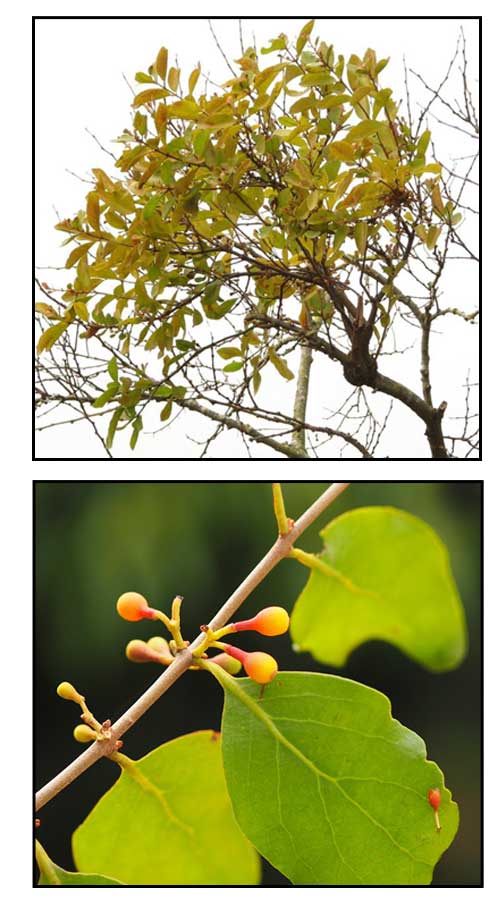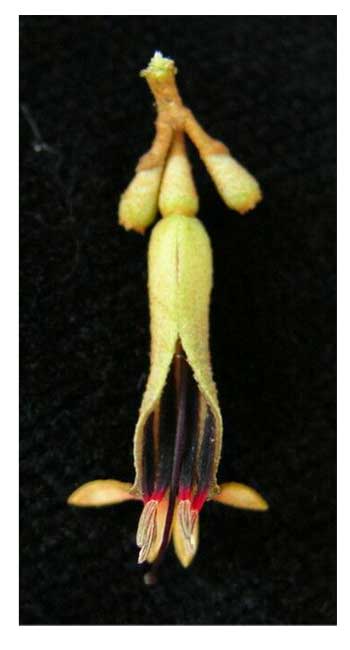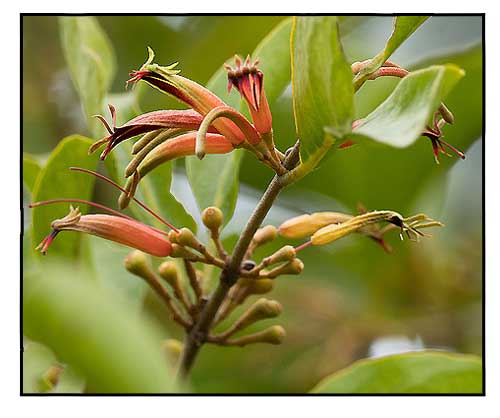 Gen info Gen info
-
Scurrula is a genus of parasitic shrubs in the family Loranthaceae, native to south-east Asia. The genus was described by Carl Linnaeus in 1753 with Scurrula parasitica as the type species. (3)
- Scurrula has low host-specificity and can parasitize various plants. (3) Scurrula parasitica is an herbaceous growing shrub parasitic on Dendrophthoe falcata (Loranthaceae) which is itself parasitic on Mangifera indica (Anacardiaceae). (12)
 Botany
Botany
• Cinnamon Mistletoe is a parasitic shrub, 0.5-1 m tall, with branches erect, woolly. Leaves are 5-9 x 3-5 cm, ovate, rounded at base and tip; golden woolly below; leaf-stalk up to 1 cm long. Flowers are borne in leaf-axils, in fascicles or in shortly stalked cymes, 16-20 together. Bract are ovate, densely woolly; sepal-cup cup-shaped. Flowers are 1.5 cm long, slender, densely woolly, petals 4, ovate, pointed; stamens 4, filaments hairless; stigma club-shaped. Berry is obovoid, densely hairy. (Flowers of India)
• Leaves opposite; lamina narrowly ovate to obovate, 3-7(-9) by 1.5-3.5(-4.5) cm, thin, cuneate to truncate at the base to a petiole 3-10 mm long, acute, obtuse or rounded at the apex; venation obscure except for the midrib and a few major laterals visible on both sides. Inflorescences several at the nodes, a 2- to 6-flowered raceme; axis 1-6 mm long; pedicels 1-5 mm long; bract narrow, erect, 1-3 mm long. Fruit 8-10 mm long including a stipe 4-8 mm long, rounded at the apex. (Flora Malesiana)
Distribution
- Native to the Philippines. (1) (2)
- Common in a range of primary forests and disturbed sites.
- In Luzon: Aurora, Bataan, Benguet, Ifugao, Ilocos Norte, Ilocos Sur, La Union, Mountain Province, Pangasinan, Quezon, Rizal; Marinduque; Palawan; Mindoro; Negros, Sibuyan; Mindanao: Zamboanga del Norte.
( 2)
- Also native to
Andaman Is., Assam, Bangladesh, Borneo, Cambodia, China South-Central, China Southeast, East Himalaya, Hainan, India, Jawa, Lesser Sunda Is., Malaya, Maluku, Myanmar, Nepal, Sri Lanka, Sulawesi, Sumatera, Taiwan, Thailand, Tibet, Vietnam. (1)
Constituents
 - Fractionation and purification of n-hexane, ethyl acetate, and methanol crude extracts of leaves yielded eight compounds identified as: quercetin (1), quercitrin (2), kaempferol-3-O-α-L-rhamnoside (3), (+)-catechin (4), lupeol (5), lupeol palmitate (6) ß-sitosterol (7) and squalene (8).
(see study below) (4) - Fractionation and purification of n-hexane, ethyl acetate, and methanol crude extracts of leaves yielded eight compounds identified as: quercetin (1), quercitrin (2), kaempferol-3-O-α-L-rhamnoside (3), (+)-catechin (4), lupeol (5), lupeol palmitate (6) ß-sitosterol (7) and squalene (8).
(see study below) (4)
- Study of crude extract of leaves isolated quercetin (1), quercitrin (2), kaempferol 3-O-D-L-rhamnoside (3), (+)-catechin (4), lupeol (5), lupeol palmitate (6), ß-sitosterol (7), squalene (8), octacosane (9), octadecane (10) and eicosane (11).
(see study below) (5)
- Methanol extract of leaves revealed presence of saponins, alkaloids, tannins, phenolic compounds, sterols, flavonoids, glycosides and carbohydrates, with absence of terpenoids, proteins, amino acids, fixed oils, and fats. Ethyl acetate extract yielded only saponins, alkaloids, sterols, flavonoids, glycosides, and carbohydrates.
- Study of stem and leaves of Scurrula parasitica parasitic on Nerium indicum isolated a new triterpenoid ester, 7ß-hydroxyl-hop-22(29)-en-3ß-O-palmitate (1), along with nine known compounds, uvaol (2), 3-epi-ursolic acid (3), 3β-hydroxyl-hop-22(29)-ene (4), 3β, 15α-dihydroxyl-lup-20(29)-ene (5), lup-20(29)-en-3-O-α-D-glucoside (6), stigmasterol-3-O-β-D-glucoside (7), digitoxin-3-O-α-D-glucoside (8), behenic acid (9), octacosyl alcohol (10). (16)
Properties
- Studies have suggested anticonvulsant, antioxidant, antimicrobial, tyrosinase inhibitory, antitumor, antinociceptive, anticancer, blood sugar lowering, neuroprotective properties.
Parts used
Leaves.
 Uses Uses
Edibility
- In China, leaves used in the formulation of herbal drinks.
- Fruit reportedly edible. (14)
Folkloric
- No reported folkloric medicinal use in the Philippines.
- In folk medicine, used for diuretic effect.
- Decoction of whole plant used for treatment of cancer.
- In China, used as ethnomedicine as shock therapy for schizophrenia. Branches used for its cytotoxic activity against cancer. (10)
- In southern China, leaves and stems reported to be used as antioxidants, cardiotonic, and antineoplastic. (5)
- Used as ingredient in traditional medicine for treatment of hypertension, back and knee pain, and to increase bone strength (Sunaryo & Uji, 2010). (13)
Others
- Fodder: Entire plant reportedly used as fodder. However, there are reports that the shoots induce vomiting and loss of appetite in livestock. (14)
Studies
• Anticonvulsant / Leaves: Fractionation and purification of n-hexane, ethyl acetate, and methanol crude extracts of leaves yielded eight compounds. Compounds 1, 4, 5, and 6 were investigated for anticonvulsant potentials using maximal electroshock test (MEST) in chicks and pentylenetetrazole-induced seizure test in mice. Effect of compounds on motor coordination was evaluated using beam walking assay. Results suggest the isolated compounds possess mild anticonvulsant potential and may be beneficial in the management of petit mal epilepsy. (see constituents above) (4)
• Antibacterial / Antioxidant Tyrosinase Inhibitory / Leaves: Study of crude extract of leaves isolated quercetin (1), quercitrin (2), kaempferol 3-O-D-L-rhamnoside (3), (+)-catechin (4), lupeol (5), lupeol palmitate (6), ß-sitosterol (7), squalene (8), octacosane (9), octadecane (10) and eicosane (11). Compounds 1, 2, 3, and 4, together with ethyl acetate and methanol extracts exhibited effective antioxidant activities against DPPH, ABTS, and FRAP assays. The EA extract showed highest tyrosinase inhibition value of 66.02%, while quercetin showed highest % inhibition of 79.09%. All extracts and isolated compounds showed weak antimicrobial inhibition except for quercetin, which showed moderate activity against Pseudomonas aeruginosa with MIC and MBC of 250 µg/mL. (5)
• Antioxidant / Leaves: An ethanol extract of leaves showed maximum invitro antioxidant activity on DPPH free radical scavenging assay and 50% ethanol extract showed highest antioxidant activity for FRAP and Total Phenolic Content assay. The extract improved invivo antioxidant status viz., SOD, catalase, GPx, and MDA in STZ-induced diabetic rats. (6) Study evaluated petroleum ether, chloroform, ethyl acetate, and methanol extracts of leaves for phytochemicals and antioxidant activities. Phyto-chemical screening revealed alkaloids, flavonoids, saponins, tannins, phenolic compounds, sterols, terpenoids, glycosides and carbohydrates. Total phenolic content were 30, 21, 38, and 42 µg of GAE in 100 µg of extract, respectively. All extracts showed concentration dependent activity. (8)
• Antioxidant / Quercetin / Leaves: Study evaluated phenolic compounds and antioxidant activity of compounds from S. parasitica leaf extract. DPPH was used for testing antioxidant activity. Spectroscopic analysis isolated and identified quercetin (quercetin-3-O-rhamnoside), which showed high antioxidant activity with IC50 of 5.00 µg/mL. Study suggests the plant as a very potential source of natural antioxidants. (7)
• Antitumor Polysaccharide: Study evaluated the antitumor activity of S. parasitica polysaccharides (SP). MTT assay detected S180, K562, and HL50 cell lines proliferation inhibition by SP. Results showed SP could down-regulated expression of Ki-67, Cyclin D1, and Bcl-2 protein, and up-regulate expression of Bax protein. Study suggests inhibition of cancer cell proliferation and promoting cancer cell apoptosis in vivo maybe one of the anticancer mechanisms of S. parasitica. (9)
• Neuroprotective / Leaves: MTT cell viability assay evaluated the neuroprotective activity of extracts and fractions of L. parasiticus leaves against H2O2-damaged NG108-15 hybridoma cells. The aqueous fraction exhibited strongest neuroprotective activity yielding 78.00% cell viability in a dose-dependent manner. The aqueous fraction also showed highest total phenolic content. Pretreatment with the AFx restored intracellular glutathione (GSH), a major endogenous antioxidant, and also reduced the production of ROS induced by J2O2. Significantly attenuated apoptotic properties, including disruption of mitochondrial membrane potential, externalization of phosphatidylserine, and reduction of H2O2- induced sub-G1 population confirmed the neuroprotecetive effect. Isolated compounds, AC trimer and (+)-catechin showed potent neuroprotective activity in NG108-15 cells with 93.38% and 102.41% cell viability. Results on both crude extracts and isolated phytochemicals support the traditional use of the plant as neuroprotective agent in ethnomedicine. (10)
• Antinociceptive / Whole Plant: Study evaluated the dried methanol extract of whole plant of Scurrula parasitica for analgesic activity using acetic-acid induced writhing (chemical stimulation), heat conduction method (thermal stimulation) in animal models. Diclofenac was used as reference standard. Extract dose of 400 mg/kbw showed significant results compared to diclofenac. Study suggests chemical entities transferred from host Dendrophthoe falcata to the parasite Scurrula parasitica are accountable for the antinociceptive potential. (11)
• Blood Sugar Lowering / Whole Plant: Scurrula parasitica is a parasitic shrub growing on Dendrophthoe falcata, which is itself parasitic on Mangifera indica. Study evaluated methanol extract of whole plant for effect on blood sugar level in oral glucose tolerance test using Wistar rats, with Glibencladmide as reference drug. Extract doses of 200 and 400 mg/kg showed significant results compared to Glibenclamide. Study suggests some chemical entities transferred from host plants D. falcata and M. indica may be responsible for the effect on blood sugar level. (12)
• Antidiabetic / Hypolipidemic / Leaves: Study evaluated the antihyperglycemic, hypolipidemic activities of ethanolic leaf extract in streptozotocin-induced diabetic albino rats. Extract doses of 100 and 200 mg/kbw were used. Metformin was used as reference. Results showed significant lowering of blood glucose level and serum lipids with rise of HDL serum cholesterol. GC-MS analysis identified 5 anti-diabetic compounds viz., Triacontanoic acid (1), hexadecanoic acid (2), 1-tridecene (3), Cyclohexane, 1-(1,5-dimethylhexyl)-4-(4-methylpentyl) (4), and Heneicosanoic acid (5). Acute toxicity study by OECD guidelines showed no toxic effects up to 500 mg/kbw. (15)
Availability
- Wild-crafted. |

![]()




 Botany
Botany

